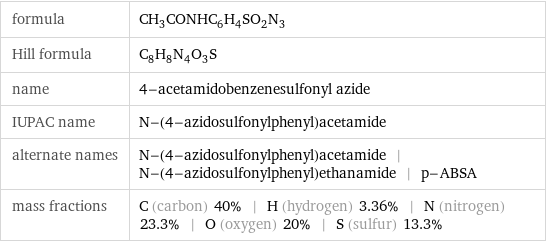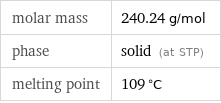Input interpretation

4-acetamidobenzenesulfonyl azide
Chemical names and formulas

formula | CH_3CONHC_6H_4SO_2N_3 Hill formula | C_8H_8N_4O_3S name | 4-acetamidobenzenesulfonyl azide IUPAC name | N-(4-azidosulfonylphenyl)acetamide alternate names | N-(4-azidosulfonylphenyl)acetamide | N-(4-azidosulfonylphenyl)ethanamide | p-ABSA mass fractions | C (carbon) 40% | H (hydrogen) 3.36% | N (nitrogen) 23.3% | O (oxygen) 20% | S (sulfur) 13.3%
Lewis structure

Draw the Lewis structure of 4-acetamidobenzenesulfonyl azide. Start by drawing the overall structure of the molecule, ignoring potential double and triple bonds: Count the total valence electrons of the carbon (n_C, val = 4), hydrogen (n_H, val = 1), nitrogen (n_N, val = 5), oxygen (n_O, val = 6), and sulfur (n_S, val = 6) atoms: 8 n_C, val + 8 n_H, val + 4 n_N, val + 3 n_O, val + n_S, val = 84 Calculate the number of electrons needed to completely fill the valence shells for carbon (n_C, full = 8), hydrogen (n_H, full = 2), nitrogen (n_N, full = 8), oxygen (n_O, full = 8), and sulfur (n_S, full = 8): 8 n_C, full + 8 n_H, full + 4 n_N, full + 3 n_O, full + n_S, full = 144 Subtracting these two numbers shows that 144 - 84 = 60 bonding electrons are needed. Each bond has two electrons, so in addition to the 24 bonds already present in the diagram we expect to add 6 bonds. To minimize formal charge oxygen wants 2 bonds, nitrogen wants 3 bonds, and carbon wants 4 bonds. Identify the atoms that want additional bonds and the number of electrons remaining on each atom: To fully fill its valence shell, nitrogen will donate one of its electrons, allowing it to form four bonds (the maximum number an element on period 2 can form). Add 6 bonds by pairing electrons between adjacent highlighted atoms. Additionally, atoms with large electronegativities can minimize their formal charge by forcing atoms with smaller electronegativities on period 3 or higher to expand their valence shells. The electronegativities of the atoms are 2.20 (hydrogen), 2.55 (carbon), 2.58 (sulfur), 3.04 (nitrogen), and 3.44 (oxygen). Because the electronegativity of sulfur is smaller than the electronegativity of oxygen, expand the valence shell of sulfur to 6 bonds. Therefore we add a total of 8 bonds to the diagram, noting the formal charges of the atoms. The six atom ring is aromatic, so that the single and double bonds may be rearranged: Answer: | |
3D structure

3D structure
Basic properties

molar mass | 240.24 g/mol phase | solid (at STP) melting point | 109 °C
Units

Chemical identifiers
![CAS number | 2158-14-7 Beilstein number | 2219568 PubChem CID number | 5129185 PubChem SID number | 24865269 SMILES identifier | CC(=O)NC1=CC=C(C=C1)S(=O)(=O)N=[N+]=[N-] InChI identifier | InChI=1/C8H8N4O3S/c1-6(13)10-7-2-4-8(5-3-7)16(14, 15)12-11-9/h2-5H, 1H3, (H, 10, 13)/f/h10H MDL number | MFCD00029626](../image_source/cc6db13482ab42f368b9b781c2d19c2d.png)
CAS number | 2158-14-7 Beilstein number | 2219568 PubChem CID number | 5129185 PubChem SID number | 24865269 SMILES identifier | CC(=O)NC1=CC=C(C=C1)S(=O)(=O)N=[N+]=[N-] InChI identifier | InChI=1/C8H8N4O3S/c1-6(13)10-7-2-4-8(5-3-7)16(14, 15)12-11-9/h2-5H, 1H3, (H, 10, 13)/f/h10H MDL number | MFCD00029626